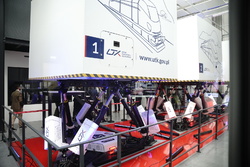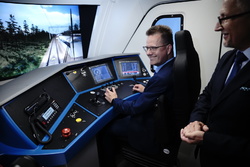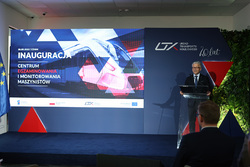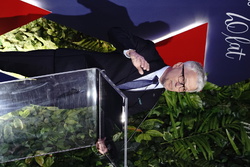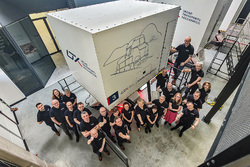Since January 2023 exams for train driver candidates are state-run and conducted by the President of the Office of Rail Transport at the Examination and Monitoring Centre for Train Drivers (CEMM) in Warsaw. New state exams and new examination venue are part of the Office of Rail Transport project 'Improving railway safety through the Examination and Monitoring System for Train Drivers', which is financed by the Cohesion Fund under the Operational Programme Infrastructure and Environment 2014-2020.
I am convinced that the state exams conducted in a uniform manner will guarantee a high level of knowledge and skills for those entering the train driver profession. In the Examination and Monitoring Centre for Train Drivers, which is a unique centre on a European scale, we will apply innovative examination methods, thanks to, among other things, the use of the most modern simulators in Poland – stated Ignacy Góra, President of the Office of Rail Transport.
Every candidate for train driver in Poland must first pass a theoretical exam for a train driver's licence. Only then they can proceed with the training for train driver's certificate and the subsequent second exam at CEMM. It consists of a theoretical part - a test and driving on a simulator - and a practical part - driving a railway vehicle.
Train driver is an extremely important and desirable profession. I encourage all railway enthusiasts to start education in this field. As a government, we are taking intensive measures to fill the generation gap in this profession, and the inauguration of the modern Examination and Monitoring Centre for Train Drivers is one of them – noted Andrzej Bittel, Secretary of State at the Ministry of Infrastructure, Government Plenipotentiary for Counteracting Traffic Exclusion.
FIRST EXAMS HELD
The first exams for train driver's licence were held in April this year. So far, 143 people took the knowledge test. 73% of the train driver candidates passed. The exams are held in a well-equipped exam space and candidates solve the tests on tablets. The exam for train driver's licence lasts 200 minutes and consists of 100 test questions. Test is divided into 8 thematic sections. A minimum score of 75 out of a possible 100 points is required to pass, but a minimum of half of the questions must be answered correctly in each of the individual parts. An exception is the section on signalling in rail transport, where even one mistake will result in failing the entire exam.
SIMULATORS
After the first train driver's licence exams, CEMM is now waiting for candidates to take the exams for the train driver's certificate. This will mean the start of exams on simulators. At CEMM there are simulators of an electric locomotive, an electric multiple unit and a shunting locomotive. These are one of the most modern and innovative equipment of their kind in Europe. The simulators are designed for exam sessions for various categories of train driver's certificate. The unique features of these simulators – compared to other simulators currently used for training in Poland – are standardised dashboards, which comply with the requirements of ergonomics and correct instrument layout and with the Technical Specifications of Interoperability for Locomotives and Passenger Rolling Stock (TSI Loc&Pas). This ensures measurable, comparable and recurrent conditions for conducting exams. The simulators use recordings of 7,090 km of real railway routes.
NEW EXAMINATION SYSTEM
The Centre provides a uniform, consistent and objective examination system. Until now, exams for train driver candidates were conducted in training and examination centres, i.e. commercial bodies with various educational offers.
With the effective use of EU funds, safety in the railway sector in Poland is increasing. The Examination and Monitoring Centre for Train Drivers is an example of this. However, it is not only a step towards greater safety, but also higher quality. The modern examination centre is changing the standards for obtaining certifications in the train driver profession. In CUPT we comprehensively support beneficiaries in obtaining funds from the European Union, thanks to which it is possible to provide the appropriate tools to achieve the objectives – says Joanna Lech, Director of the Centre for EU Transport Projects (CUPT).
CEMM is a modern, innovative examination centre on the European scale, the creation of which is part of a comprehensive project of the Office of Rail Transport to improve rail safety and examination system for train drivers. In addition to the introduction of legislative changes and the construction of CEMM, a national register of train drivers was also created as part of this project. The register brings together all available information on persons authorised to drive railway vehicles, their licences and qualifications, as well as their career paths. The register makes it possible to continuously monitor the employment of train drivers and their qualifications and allows for an effective exchange of information between employers as part of risk management systems.
The introduction by the President of the Office of Rail Transport of comprehensive changes to the examination of train drivers will contribute to improving safety of rail transport by minimising the number of railway incidents, in which the human factor plays a fundamental role. Poland is the second European Union country, alongside the Netherlands, to use simulators for examining train driver candidates.
The project "Improvement of rail safety through the construction of the Examination and Monitoring System for Train Drivers" is co-financed by the European Funds from the Operational Programme Infrastructure and Environment. It received funding of PLN 40,897,072.39.

